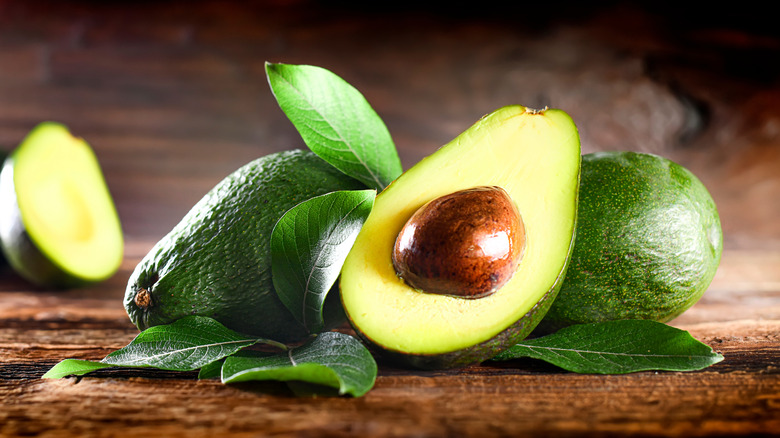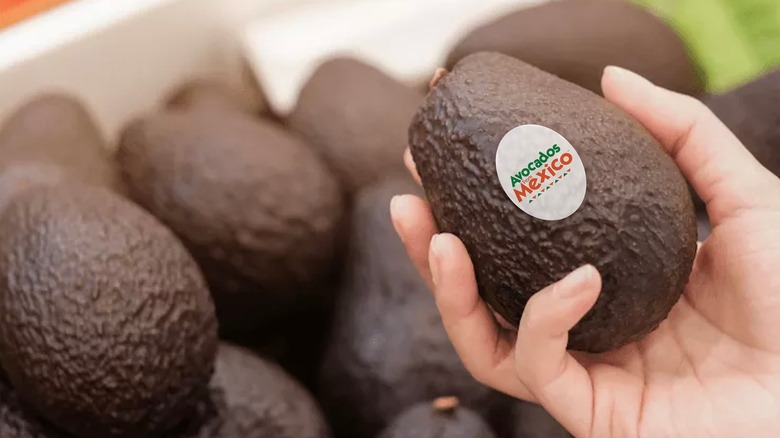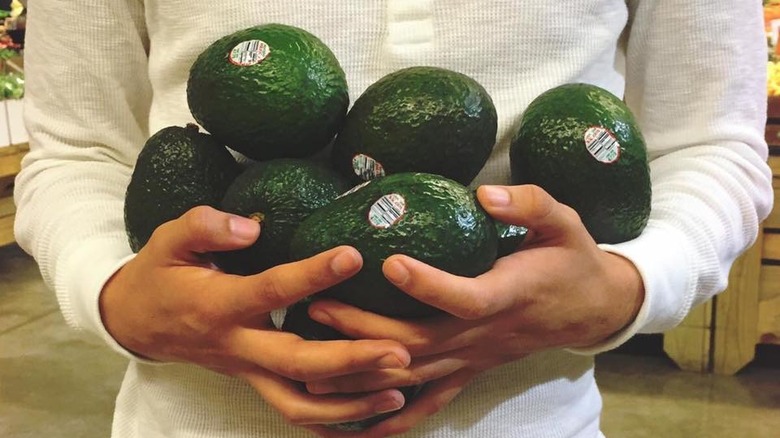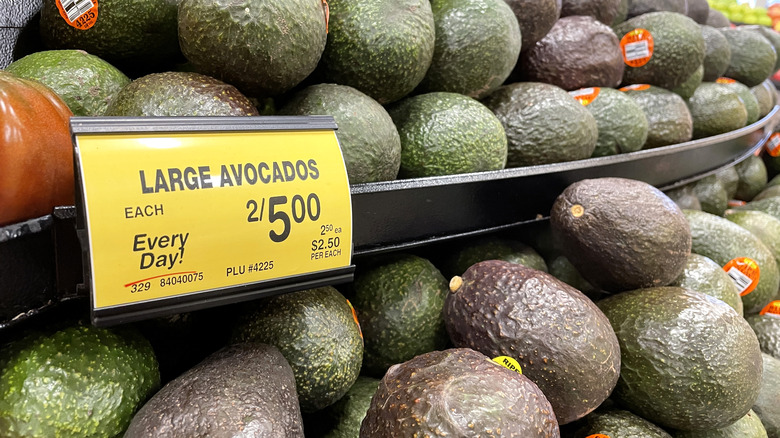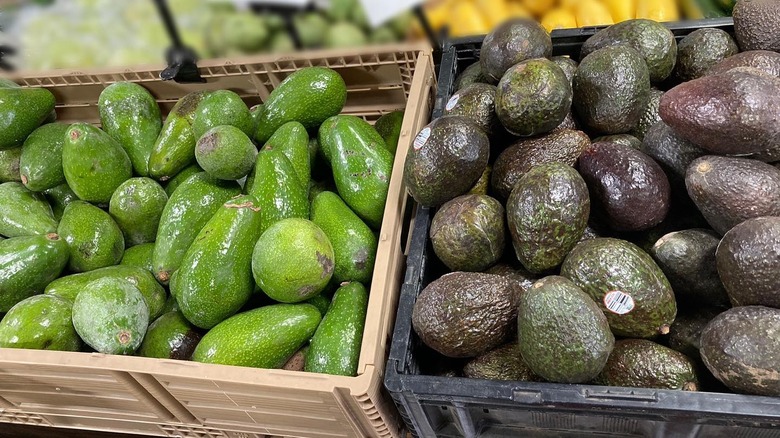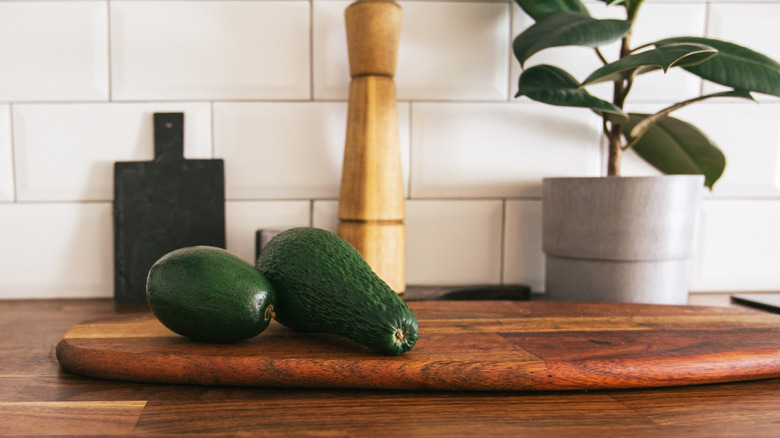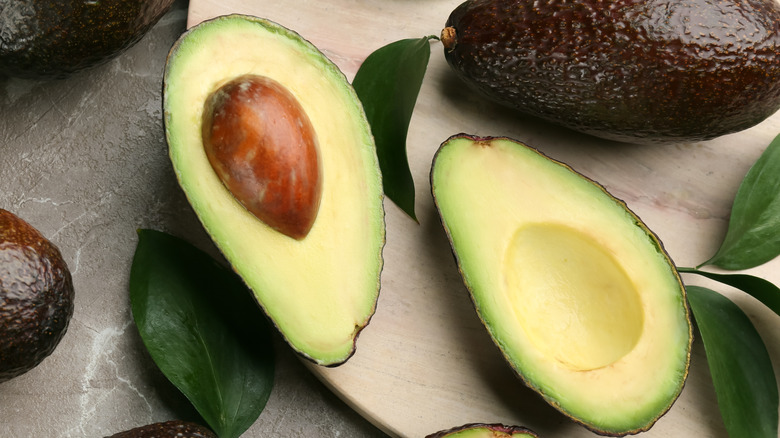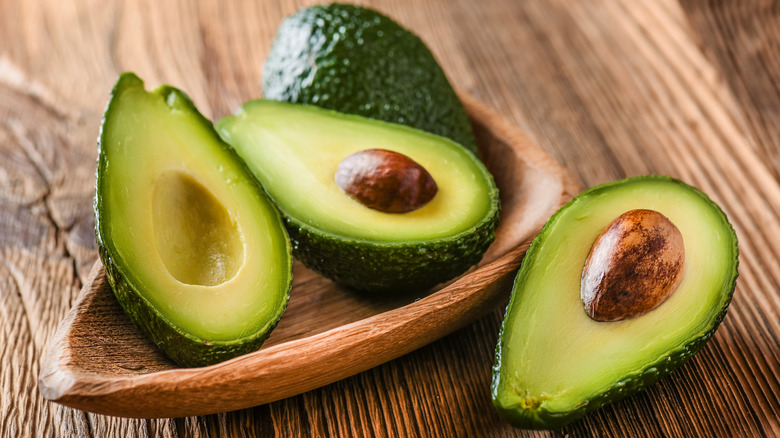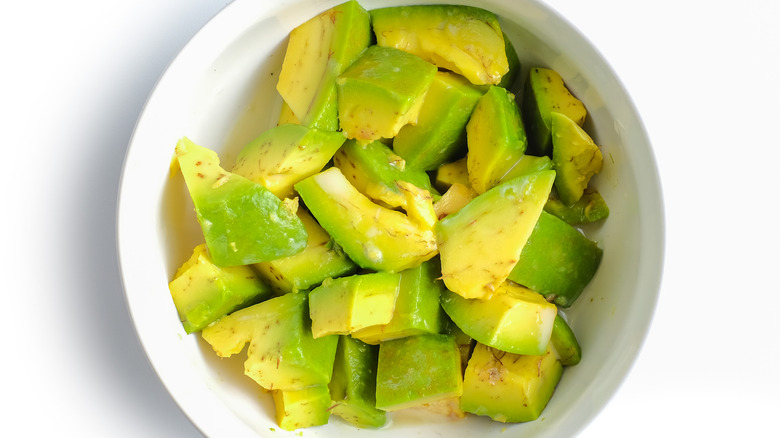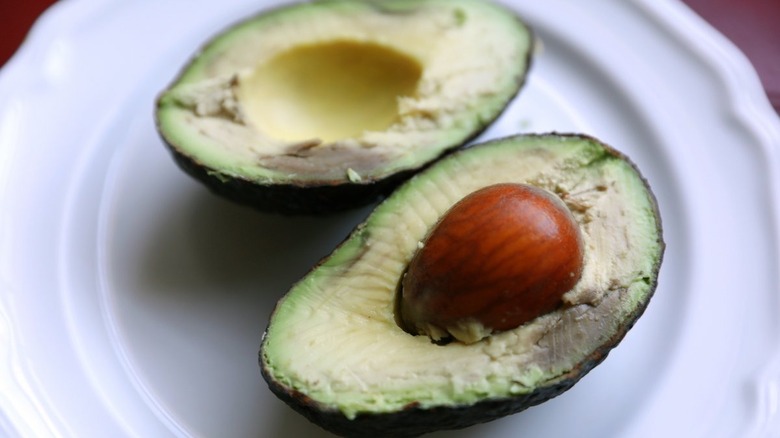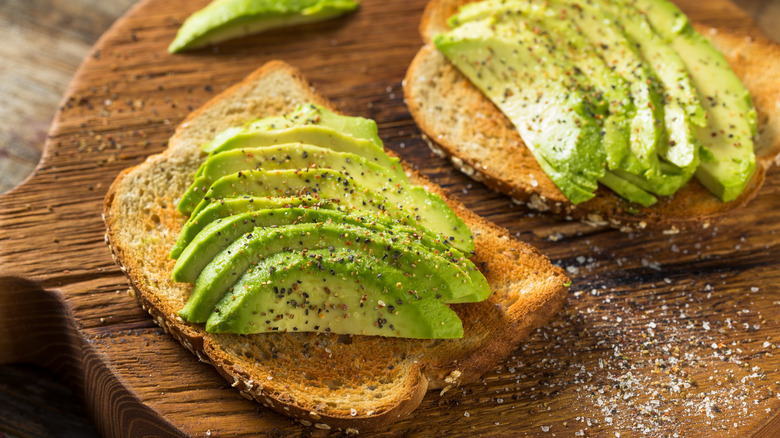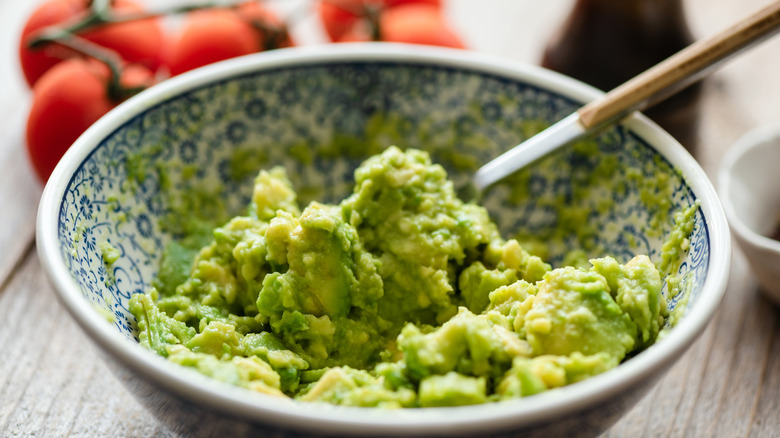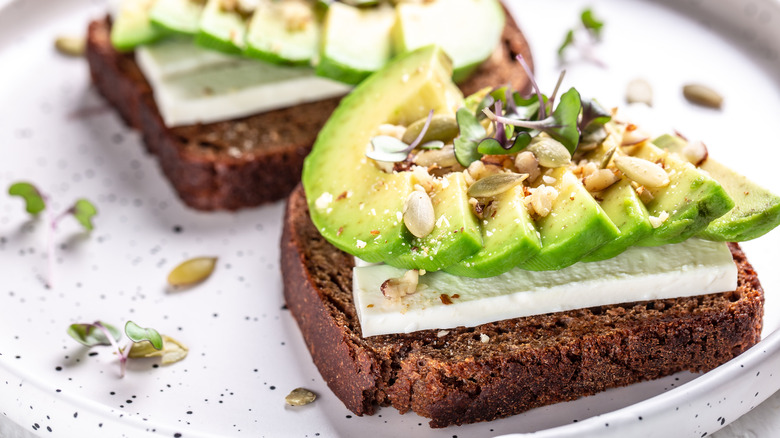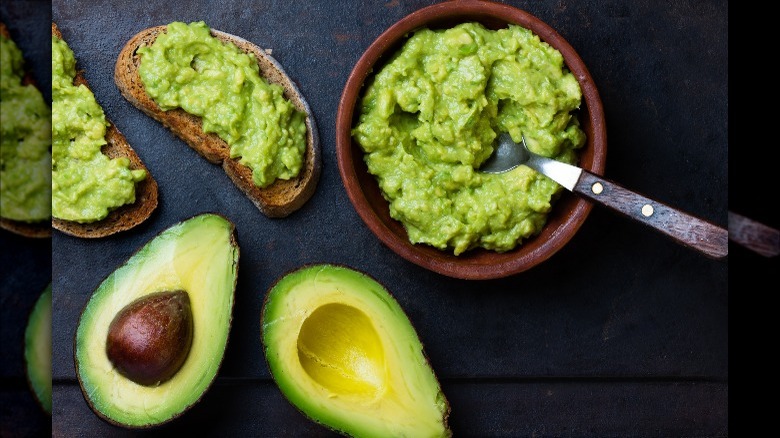Mistakes Everyone Makes With Avocados
Avocados have become a bit of a cultural phenomenon in recent years, with guacamole and the infamous avocado toast becoming nearly synonymous with the millennial generation (via The Guardian). Needless to say, the avocado has become a grocery store staple for many Americans, regardless of age. But there's more to the avocado than you may realize.
Despite their popularity, avocados can cause quite the headache for consumers. Issues like price hikes, the short shelf life, and general confusion over how to best prepare avocados have bewildered shoppers for years. Perhaps you only know avocados as that topping that cost extra at your local sandwich shop, or maybe they make up their own food group in your daily diet. No matter what your relationship to avocados is, there are a few things you may be doing completely wrong when it comes to shopping for, preparing, and eating them. The next time you head to the store to pick them up, or plan to use them in your next meal, consider these common mistakes people frequently make with avocados, and what you can do to avoid them. Before you know it, you will be an avocado master and can even help others avoid these pitfalls.
Choosing avocados incorrectly
The first mistake people make with avocados can occur before you even bring them home in your shopping bag. If you're like many shoppers, you head over to the avocado stand and start picking up the fruits, gently squeezing each one to figure out its ripeness. Rock hard? You put it back — it'll take days before you can eat it. Pillowy soft? You also pass on those, because if you don't eat them almost immediately they'll rot before your eyes.
According to Avocados From Mexico, the process of selecting the ideal avocado is quite simple. There are four factors to consider: color, taste, texture, and firmness. The darker the avocado, the more ripe and ready for consumption it is. Another visual cue is to look for bumps all over the skin that indicate ripeness. When you squeeze an avocado to check its firmness, you want to avoid ones that have obvious dents or mushiness. And if you're bold enough to taste one at home to check its doneness, it should be buttery and easily melt in your mouth.
Martha Stewart also advises shoppers to check the avocado's stem for doneness. This trick involves pulling the stem off the avocado to check for ripeness, but the site warns that this will speed up the oxidation process. Only do this trick once the avocados are at home and you are ready to eat them within a day or so.
Buying in bulk
Avocados are still one of the pricier produce items in the grocery store, tempting many of us to scope out whatever savings we can. If single avocados are not on sale, you may be able to save a couple of bucks by buying a bunch at once. Typically, avocados will be sold individually or in bags of four or five. But beware: Buying in bulk might lead to more food waste than you realize.
Avocados that are sold in bulk are usually all at the same level of ripeness. Therefore, the entire bag will likely be ready to consume at the same time. That can take anywhere from a day to upwards of a week, depending on the ripeness at the time of purchase (via Does It Go Bad). If you are only eating one of those avocados per day, you might pass peak ripeness and some of the ones in your bag will rot before you are able to eat them. Buying in bulk is a great method of saving money if, for example, are looking to make a large batch of guacamole for guests. But if it's just you and your avocados, you may want to stick to buying a couple at a time.
Spending too much
According to food-sourcing platform Selina Wamucii, the average wholesale price of avocados in the United States in 2022 is around $1.19 per pound. This price is the result of an overabundance of Peruvian avocados which caused a 27% drop in wholesale prices from Mexico, one of the biggest global producers of avocados in the world, in the summer of 2022 (via CNBC).
Despite the lower prices, avocados are still on the higher end of what you'll pay per serving among other produce at the supermarket. They are definitely one of those grocery items you need to plan and budget around, otherwise you may find yourself wasting more money than you realize. Consider skipping organic avocados to save over time, and only buy what you realistically expect to eat in an average week. If you notice that you keep throwing avocados away, pull back on how many you purchase and you will find that you save money in the long run. And try following the advice of shopping app Ibotta, which compiled data showing that avocados tend to be the cheapest on Wednesdays, and most expensive on Sundays.
Sticking to only one kind of avocado
Did you know that there are over 500 varieties of avocado (per University of Florida Institute of Food and Agricultural Sciences)? The crop is grown in tropical areas all around the world, and each different environment yields unique results. While you may only find your traditional Hass avocado in your local grocery store here in the U.S., you can check with your local farmers markets to see if there are other varieties available. Branching out and trying different types of avocados will allow you to discover your favorite, and can help you unlock different ways of preparing avocados.
As it turns out, not all avocados are created equal, so pay close attention next time you bite into one and figure out which ones work best for you. The University of Florida suggests that Hass avocados are ideal for preparing guacamole, but you can also experiment with Brogdon and Fuerte avocados. And if you are looking to be slightly more health-conscious, it's worth noting that a Florida avocado will have less calories than a Hass avocado.
Storing avocados incorrectly before use
When you bring your avocados home from the grocery store, you may have a designated place in your pantry to keep them. But the way that you store these fruits before use can have a drastic impact on the quality of your avocados. According to Real Simple, if you want your whole avocados to last as long as possible before eating, you should store them on your counter away from other produce. They should be good for up to five days that way. The site also points out that you want to monitor your avocados closely each day to make sure you aren't missing their peak ripeness.
There's also a legitimate health reason for why you want to make sure you store your whole avocados correctly. The FDA conducted a study in 2014 that revealed that nearly 1% of the avocados collected and sampled had traces of salmonella on their skin, and nearly 18% of avocados collected had traces of Listeria monocytogenes on their skin. So regardless of where you choose to store your avocados, be sure to rinse them with water before consumption. These findings also resulted in the FDA warning against the storing of whole avocados in water, which became a viral trend in early 2022 (via Today). The FDA says storing avocados in water only encourages the potentially present bacteria to multiply. Instead, rinsing your avocados and storing them on the counter will ensure you are eating them safely.
Making the removal of the pit unnecessarily difficult
While you might be excited to eat your avocados, there are many who dread the task of actually preparing them. It can be a messier ordeal than you might realize. For starters, there are much simpler ways of peeling an avocado than the peculiar paring knife method we saw recently on "The Great British Baking Show." There are also easier ways of removing the pit than the methods you may have tried in the past.
Did you know that there's a way of removing the pit from an avocado without the use of a knife, or any utensil at all for that matter? The viral TikTok trend involves placing your index and middle finger on the exposed flesh side of the avocado, framing the pit. Then, gently push the pit out by applying pressure on the skin side with your thumb. There may be some cleanup required — depending on how mushy the avocado is, there will likely be some remnants on your fingers. But not having to worry about slicing your fingers off by whacking a sharp knife into the pit makes for a much less stressful experience.
Exposing the flesh too soon
Once the inside of an avocado is exposed to air, the ripening process will occur much more quickly. The Martha Stewart "stem trick" will come in handy here — it involves popping the stem off an avocado to check for ripeness. If your avocados were not quite ready to eat when you do this, they will be in no time at all. That's because removing the stem exposes the inside flesh to air, which will result in quicker ripening. This might be ideal if you want to speed up the process and get snacking sooner, but don't make the mistake of forgetting about your avocados or they will rot.
Similarly, if you only need one half of an avocado for whatever dish you are preparing, be ready to eat the other half relatively soon afterwards. There's nothing quite as sad as throwing away half an avocado because it sat forgotten in the fridge. Just like when you are shopping for avocados in the store, you want to make sure you are planning out when you expect to eat your avocados, and that includes the leftover halves.
Not storing avocados properly after cutting
While no one wants to be forced to throw away a rotten avocado half, sometimes you simply aren't ready to finish the fruit right away. You might be wondering if there is any way at all to make them last longer. According to Love One Today (run by the Hass Avocado Board), sprinkling a dash of lemon or lime juice on the flesh will help in the preservation process and will keep the avocado fresher for longer. Make sure you leave the skin on to help minimize exposure to air. Avocados From Mexico also advises covering the exposed flesh in olive oil. Regardless of what you use to cover the flesh, make sure you are using an air-tight covering, like plastic wrap, before placing your avocado half in the refrigerator.
You can probably leave your avocado uncovered in the fridge if you know you are going to eat it within a day, as a writer for Insider discovered. Any longer than that, however, and you are going to want to find a way to slow down the oxidation process. Insider suggests making sure the plastic wrap is as tight to the flesh as possible, so you may want to consider removing the pit (if you have not done so already) to reduce any air bubbles that may occur.
Not removing the brown parts of the flesh
Oxidation is a natural process that occurs in many produce items, from apples to bananas to potatoes, and avocados are no exception. You will know oxidation has occurred when you see some browning on the flesh.
Those brown spots that appear after you cut open and avocado are completely safe to eat, according to a food scientist who spoke to Well + Good. But you may find the texture off-putting, so simply slice the browned sections off and enjoy the rest of your avocado. If the inside of your avocado is already brown when you first slice into it, that indicates early oxidation due to improper storage. It may also be the case that the avocado was dropped and is slightly bruised. These are also safe to eat once you cut around those brown sections.
If there are brown or black spots covering the flesh, however, that indicates that the avocado has been rotting and should not be consumed (via Healthline). If you find that the flesh has a stringy texture, that could also indicate a rotting avocado that you are better off tossing in the trash.
Only consuming avocados one way
Avocados are a common ingredient on tacos and sandwiches, or as toppings for rice bowls, salads, and more. While simply slicing and serving an avocado in its natural state is a perfectly fine way of eating one, there are a number of other ways to prepare them that you may want to consider. Simply put, if you are only eating an avocado one way, you are missing out.
Of course, a super popular preparation method is to mash avocados and make a guacamole dip. But did you know you can also grill avocados? According to A Couple Cooks, grilling avocado gives them a nice smokey flavor that will enhance whatever dish you choose to add them to. Avocados are also a great ingredient to add to your smoothies. According to Martha Stewart, the creamy texture of avocados lend themselves to blended beverages, and since avocados do not inherently have any strong natural flavors, you may not even notice them in your drink while you're enjoying all of the added nutrients. The BBC even came up with an entire list of unique ways to prepare avocados, from freezing them into popsicles or using them as a baking ingredient when making muffins.
Food consumption aside, avocados can also provide major benefits to your skin. The Huffington Post suggests spreading mashed avocado onto your face or body to treat sunburns, prevent wrinkles, and moisturize your skin.
Not mashing your avocados properly
Sliced avocado is a common way of consuming the fruit, but one of the most popular uses for avocados is mashing them into a dip for your chips or vegetables. The creamy texture of mashed avocado can also be great to use in pasta sauces, salad dressings, or for avocado toast. However, the way you mash your avocado can affect the consistency you achieve — and that matters depending on how you plan to use your mashed avocado. Livestrong advises those wanting to mash avocados for guacamole to use the back of a fork. You only need to mash for about one minute –- and there's no need to remove all of the lumps, as they tend to make for a better texture for your chunky dip. If you're looking for a creamier mash, which is ideal for a sauce, a potato masher is a better bet.
Not seasoning well
Some people enjoy the light flavor of avocados, and simply slicing and serving as-is can work wonders in some cases. But due to their subtle taste, avocados can also take well to being seasoned in a number of ways that enhances whatever dish you are creating, and we highly recommend that you utilize your spice rack before you eat an avocado. Even adding a dash of salt and pepper can make a huge difference. Avocados From Mexico also suggests other spices like paprika or ranch seasoning for some extra flavor. Lemon and lime juices, like those used in guacamole, can add just the right zing to an avocado. Or you can drizzle some olive oil or balsamic vinegar — essentially, whatever dressing you would use on a salad with avocado should work with just an avocado, too. Spend some time experimenting in the kitchen to find out which ways you like to enhance your avocados. You may like to season them one way when you are adding them to a slice of toast in the morning, but choose to flavor them differently when making a batch of guacamole.
Eating too many at once
While avocados are yummy, versatile, and very healthy, that doesn't mean you can't have too many of them. According to the Cleveland Clinic, an average-sized avocado comes packed with healthy monounsaturated fats, but it also comes packed with calories — anywhere from 200 to 300 calories, to be precise. If you are calorie-conscious, this might be something to keep in mind when you are meal planning. Though because it is true that avocados are packed with other beneficial nutrients — including nearly two dozen vitamins and minerals — the added calories may be well worth the trade-off. After all, according to Women's Health, half of an avocado contains more potassium than one whole medium banana.
Avocados can also help to lower bad cholesterol, which can in turn lower your risk for heart disease, according to the American Heart Association (via Women's Day). So finding unique ways to incorporate avocados into your breakfast, lunch, or dinner routine can be a great tool to adding much-needed nutrients to your diet. But keep in mind that devouring an entire bowl of guacamole with high-sodium tortilla chips may not be the best way to do so.
